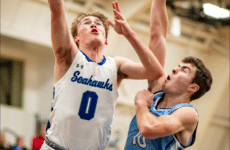
Media Credit: Mosaic Staff - Salve Regina goaltender Mike McDonald receiving a fresh elbow to the face. Dangerous, irresponsible contact?
By Mike McDonald –
It is still a blur for D.J. Watkins.
After a body check on an opponent along the boards during, the 6-foot-1 forward felt as if it was just like any other hit.
As soon as he started skating away, however, Watkins realized something was not right. Striding towards his team’s bench, he fell to the ice. He rose to his skates and fell again. He stumbled three to four more times before finally getting to the bench. That night, Watkins head began to throb; he remembers not being able to speak. The next day, his mother took him to the hospital where Watkins was diagnosed with his first concussion.
“It was probably some of the worst pain I’ve been in in my life,” Watkins recalled, now a freshman on the Salve Regina University Seahawks hockey team.
Concussions in contact sports, from the amateur or professional ranks, have gained national attention over the past several years. The journal Neurosurgical Focus released its alarming findings after studying junior-level hockey players. The study followed 52-game study of 67 male players, 16 to 21 years old. 17 of those players suffered 21 concussions. The study cautioned that, “The aftermath of a concussion can impact memory, judgment, social conduct, reflexes, speech, balance and coordination. Epidemiological studies have suggested an association between sport concussions and both immediate and later-life cognitive impairment.” The concern with concussions in contact sports has reached heightened levels of attention, as far as being discussed in U.S. Congressional hearings.
The Maple Ridge News (Maple Ridge, BC, Canada) reported that one of the other main concerns regarding concussions is the lack of knowledge that players about this type of injury. Unlike noticeable pain in a muscle or ligament injury, it is difficult for a player to recognize all the immediate symptoms of a concussion. University of Texas-Arlington study found that 56 percent of high-school sports concussions go unreported. That number is expected to be higher in college and professional athletes.
Is it the conduct of the players that is leading to players becoming more dangerous or is society just simply becoming more attentive to this dangerous injury?
“Kids have gotten bigger, strong and faster. Back when I was a kid growing up, big kids were slow and small kids were fast,” said Ryan Mulhern, head coach at St. George’s school in Newport. “Now everybody’s big; everybody’s fast and explosive.”
Mulhern, whose team saw four players suffer concussions over one season, believes that it is the “out of control” on-ice behaviors that have led to players to become more susceptible to injury. “The idea of a body check is to separate the player from the puck, not put them out for the next three to four weeks,” Mulhern explained. “Now players are using their bodies as a projectile to just level people and get the crowd to cheer.”
Mulhern explained out that a lack of personal protection also plays a role; he notes how players often play with their helmets on loose. He also discussed how players have become less concerned with their own safety and improperly wearing mouth guards. “Every shift I see a mouth guard on the ice,” he said.
John Mackay, head athletic director and football coach at St. George’s, believes that the concussions have become such a big issue, not because of the recklessness of players, but because the heightened focus on player safety. “People are just much more aware and cautious,” Mackay said. “I don’t know if the game has changed, it’s just the greater focus on safety and how people teach how to teach football.”
Whether it is the conduct of players or simply a greater attention to player safety, several measures have been begun on a both a national and local level to protect athletes in contact sports.
Katherine Boynton, an athletic trainer at Salve Regina University, explained a new NCAA policy regarding the treatment of athletes with possible concussions. In the past, athletes who demonstrated concussion symptoms were required to wait 20 minutes. After the 20 minutes, if the symptoms had subsided, the athlete was permitted to return to play. “But now, they’ve changed that,” Boynton said, “Even if the symptoms do subside they don’t go back in that day of play. They can resume play the next day, but they’re out for that day of competition.”
At St. George’s, both the athletic program and individual sports have taken measures to better protect players from dangerous play. The school has created a “concussion management” policy, according to Mackay. Under this policy, players who suffer concussions are taken into special consideration before being cleared to return to play. The objective of this policy is to make sure that players do not suffer recurrent concussions, or second-impact syndrome. Second-impact syndrome can cause rapid brain swelling and long term degenerative effects.
At Salve, contact sport athletes are required to take an impact concussion test at the beginning of each year. The test is administered as a baseline test. Should an athlete suffer a concussion, he or she cannot return to play until they score as well on the baseline test. New this year is a test provided to non-contact athletes, known as a SAC test. The test is paper based and functions the same as the impact test for clearing athletes to return to action.
On the individual sport level, Ryan Mulhern has seen improvements on both the league and team level. The New England Prep School Ice Hockey Association (NEPSIHA) has passed a rule similar to its NCAA counterpart which assesses a 5-minute major penalty and an automatic game suspension for hits that are deemed as an “intent-to-injure.” While only called at the referee’s discretion, Mulhern said that the officials had done an excellent job in enforcing the rule properly.
Mulhern also noted how the hockey programs have taken strides to protect the players. All teams, varsity and JV, are equipped with the Cascade M11 hockey helmet. The helmet has been engineered specifically to reduce head trauma due to contact with the head.
There is still much discussion on whether the emphasis on concussions today is due to an increase in the frequency in injuries or that it is simply because of a greater level of concern towards player safety. It is certain on both the national and local levels, however, that significant strides are being taken to continue to reduce the risk of concussions in sports today.














